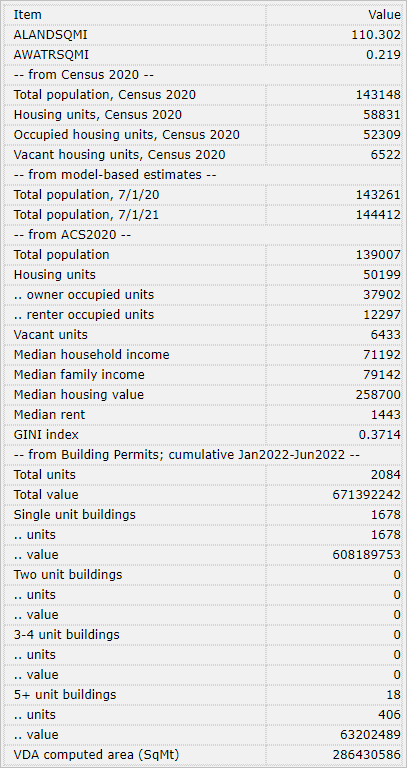.. access/analyze monthly building permits data for any/all of 7,700 cities in a few minutes via a web browser. Building permits data, a leading economic indicator, are one of the few current indicators available at the city level to examine characteristics and trends. These data can provide insights into the type and value of housing that is being added. Use the VDA Web GIS to examine how the housing situation is changing for cities of interest.
The VDA Web GIS MetroDynamics city layer/dataset is updated with the most recent 6 months of the number of housing units by type and value. The current data provide monthly aggregated data for January 2022 through June 2022. The layer/dataset includes many other attributes (see details). Of the ~19,000 U.S. cities, ~7,700 issue monthly building permits and accessible via this resource.
Examining City Housing Characteristics & Trends
An example: cities in the Phoenix, AZ area labeled with the total building permits.

.. table under map view shows cities with largest number of building permits.
.. see steps to develop the above map and table.
Illustrative Profile for Surprise, AZ
.. selected items from MetroDynamics City layer/dataset
.. integrated subject matter from several sources
.. building permits most current

About VDA Web GIS
VDA Web GIS is a decision-making information resource designed to help stakeholders create and apply insight. VDA Web GIS has been developed and is maintained by Warren Glimpse, ProximityOne (Alexandria, VA) and Takashi Hamilton, Tsukasa Consulting (Osaka, Japan).
About Building Permits Data
Building permits data are collected monthly by the Census Bureau from permit issuing agencies. Monthly data are reported for access within one month of the reporting date. Data are collected on the number of new housing units authorized by type of units in building by value.
About the Author
Warren Glimpse is former senior Census Bureau statistician responsible for national scope statistical programs and innovative data access and use operations. He is also the former associate director of the U.S. Office of Federal Statistical Policy and Standards for data access and use. He has more than 20 years of experience in the private sector developing data resources and tools for integration and analysis of geographic, demographic, economic and business data. Join Warren on LinkedIn.





